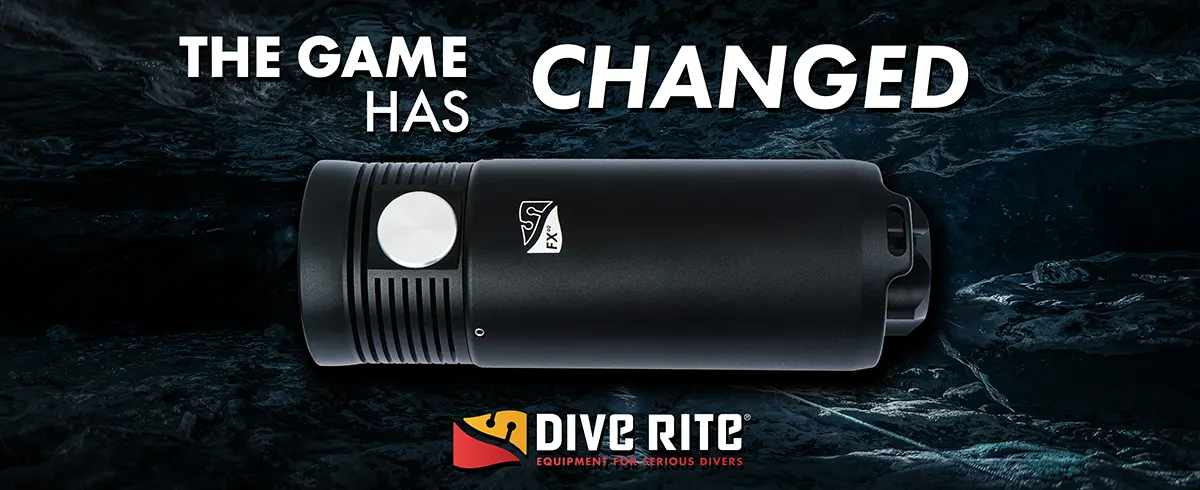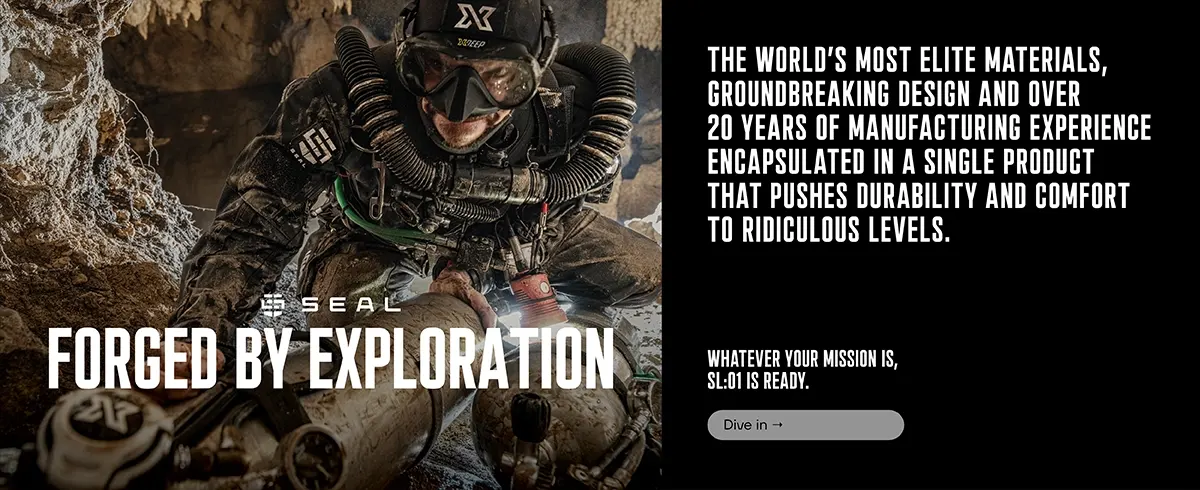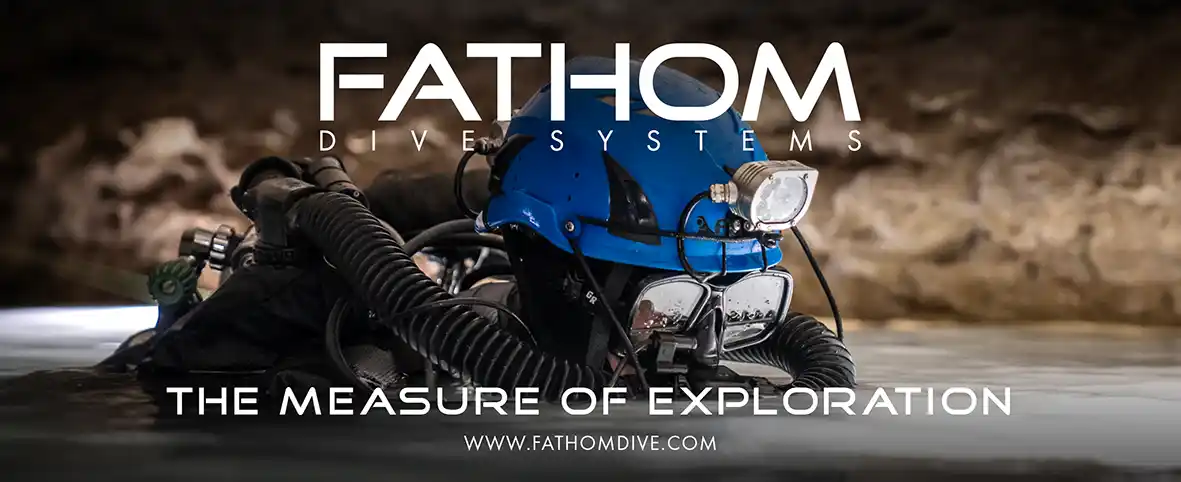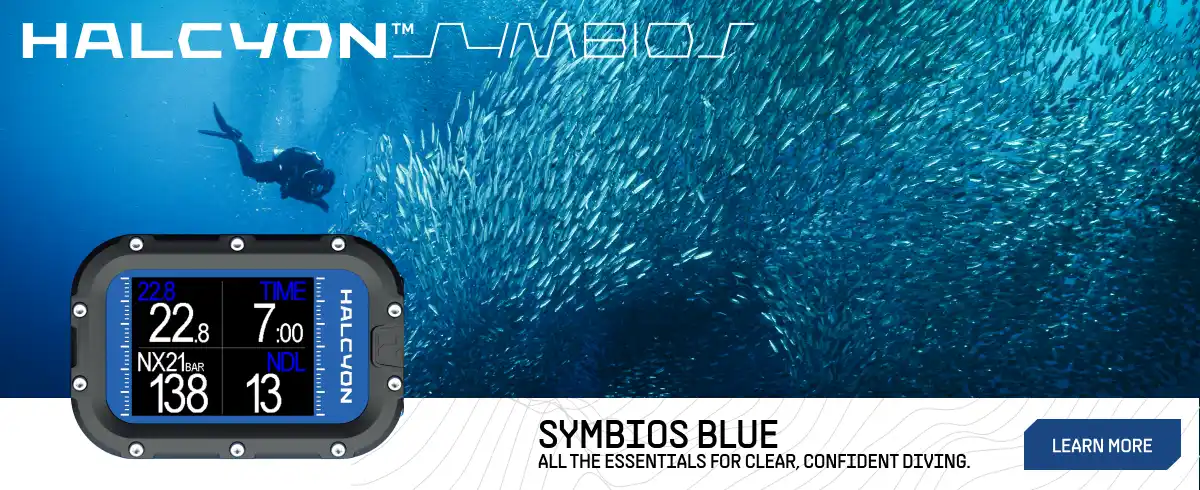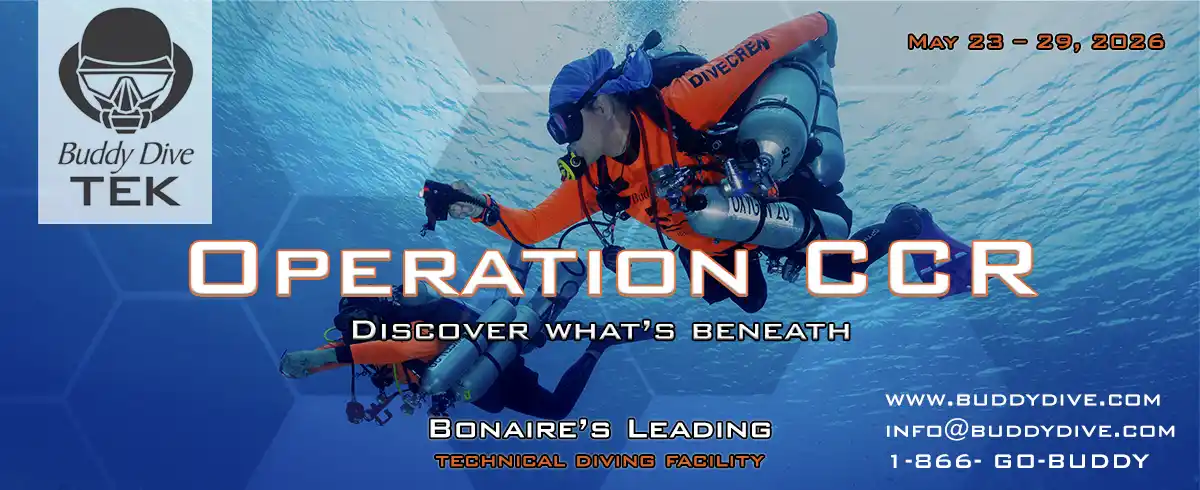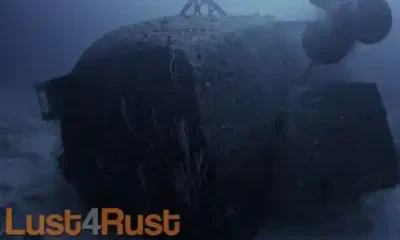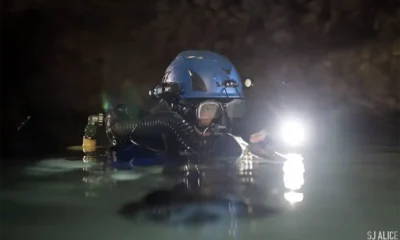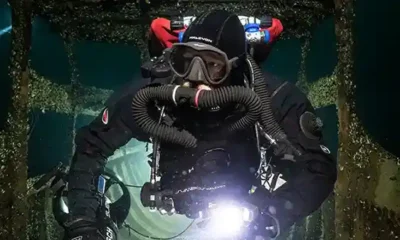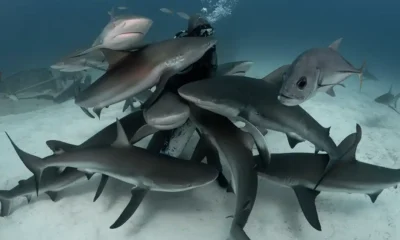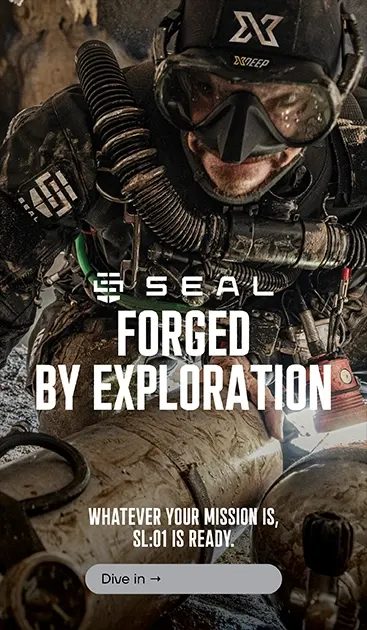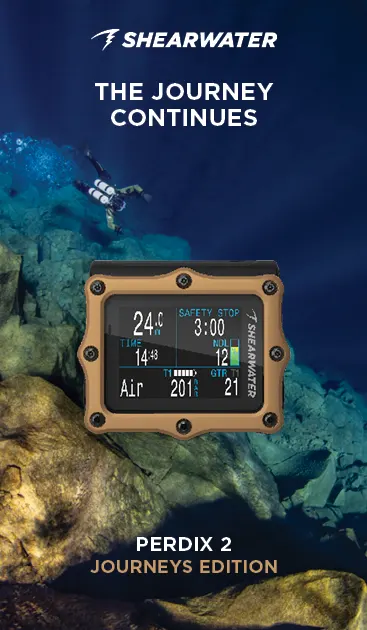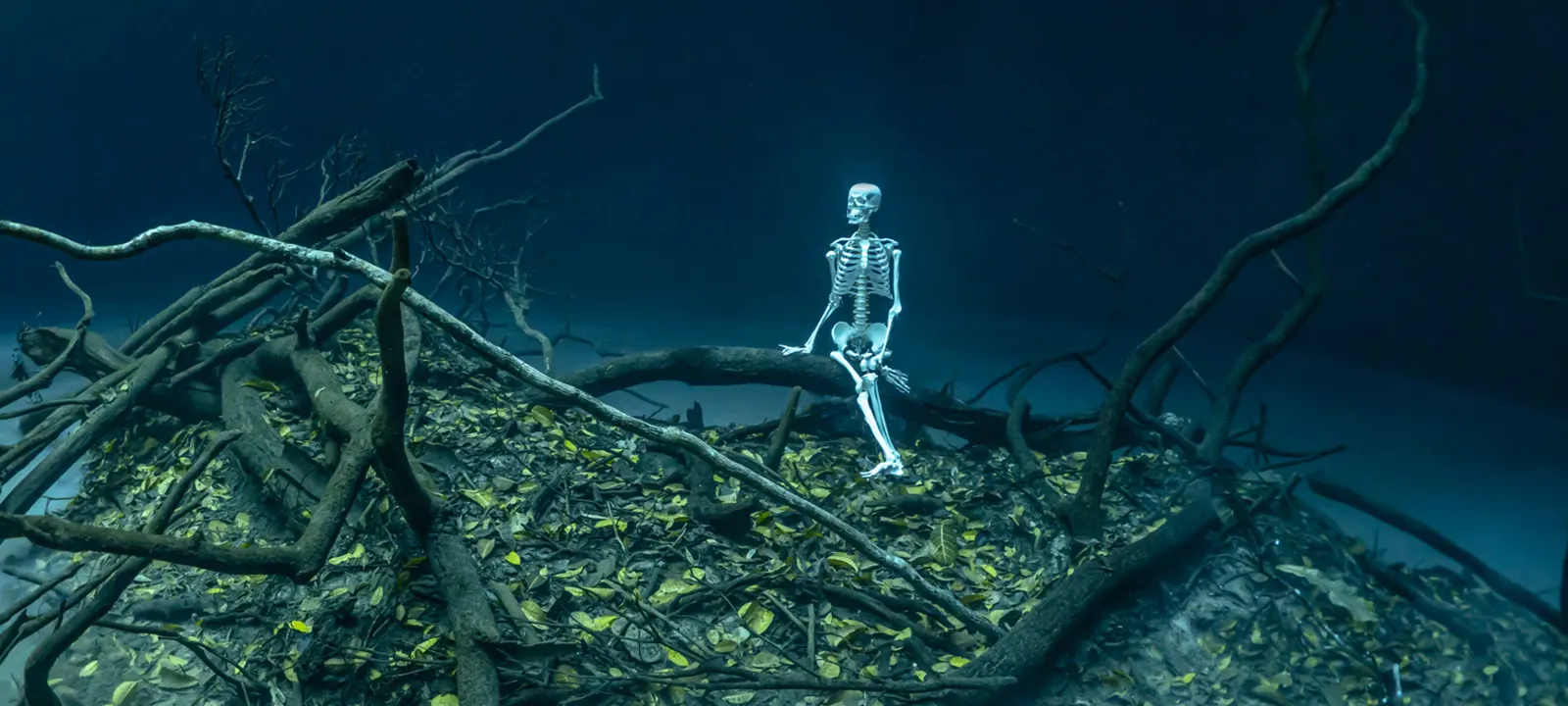

Latest Features
Was Sheck Wrong?
Cave Diving instructor and bestselling author Stratis Kas gently re-opens the gas-planning gospel with one provocation: what if Sheck Exley’s iconic Rule of Thirds was never meant as a universal life-insurance policy? Drawing on modern physiology and incident data, Kas shows how stress spikes and kit failures can shred the neat 1⁄3-1⁄3-1⁄3 calculus—and sketches smarter, situational reserves for today’s overhead dives.
Questioning Sacred Cows—and why the Rule of Thirds is not the universal safety net you think it is.
By Stratis Kas. Lead image: Cenote Angelita, Mexico by Valentina Cucchiara and Naiara Altuna. Special thanks to Lamar Hires and Andrew Vandergrift from Dive Rite for checking the logic and the math!
For nearly half a century, cave divers have revered the Rule of Thirds as if it were a creed: one-third of your gas to venture inward, one-third to leave, one-third to spare. Sheck Exley, the soft-spoken Floridian who wrote the rule into his 1979 pamphlet “Basic Cave Diving: A Blueprint for Survival,” meant it as an elegant guardrail against hubris. Elegance, however, has a habit of ossifying into dogma.
The original rule assumes a metronomic heart and lungs, serenely pumping through the return as they did on the way in. Yet anyone who has watched a pressure gauge flutter during a moment of underwater alarm knows how quickly calm arithmetic gives way to a physiology determined to survive. When the pulse vaults, the Rule of Thirds can shrink to the Rule of Regret.
So—was Sheck Exley wrong? Or are we wrong for immortalizing a principle never meant for worship? The question is less a denunciation than an invitation: to unbutton the tradition, weigh it against twenty-first century realities, and ask whether the Rule of Thirds remains a lifeline (or has tightened, imperceptibly, into something softer and far more dangerous).
The truth is that, although the Rule of Thirds is popularly credited to Sheck, virtually every cave diver alive has planned dives by its fractions—often without ever uttering his name. It is the low‑hum mantra you hear in tailgate briefings from Ginnie Springs to the Yucatán, a shibboleth so familiar it feels like natural law. In writing this piece I am not here to diminish Exley—how could I?—but to caution, especially the newly certified, that none of us are Sheck.
If catastrophe strikes at maximum penetration, the Rule of Thirds will almost certainly be too lean to bring you home. The rule behaves gorgeously on a whiteboard and grotesquely in real life. Survivors of full‑on gas failures did not walk out because of Thirds; some current, teammate, or random mercy stretched their margin. They were lucky. Luck is not a gas‑management strategy.

Improvement Over Chaos
Long before any formal gas management “rule,” Florida’s pioneers hauled their cylinders into the aquifer guided by little more than bravado and a back-of-the-napkin ratio: breathe sixty percent of your gas on the way in and trust the river-strong spring flow to do half the work on the way out.[1][2] It was a gambler’s metric—fine until the current slackened, a valve free-flowed, or a heart pounded faster than forecast. Between 1969 and 1979, that faith-based arithmetic contributed to a grim ledger of 109 cave diving deaths.[3] Sheck replaced chaos with calculation—but diving has changed, and divers have changed, while Thirds has not. That gap is the problem.
Exley himself was never static: He rewrote tables, swapped tank sizes, experimented with mixed gas, and hung extra cylinders deep in the cave to push a little farther. After his death in 1994, the community canonized the first draft of Thirds instead of the living method that inspired it. Lest we forget to question everything, adjust constantly, stay humble before the cave. The result is a widening gap between modern dives and a rule forged for the past, and explorers who knew they were rolling dice every time they slipped beneath the surface.
Meet the Man Behind the Rule-of-Thirds

To understand why the Rule of Thirds became gospel, we first have to meet that gospel’s author. Sheck Exley—born in 1949, raised among the moss-draped oaks of North Florida—took his first fin kicks inside a limestone corridor before he was old enough to vote. Long before Instagram trophies and GoPro confessions, he was quietly amassing a résumé that still makes seasoned explorers whistle. By the mid-eighties, he had logged more than 1,500 cave dives, traced virgin passage in Mexico’s Yucatán, and plunged 300 m/1,000 ft down the black shaft of Nacimiento del Río Mante, breathing plain air from the same steel doubles many of us now keep as museum pieces.[4]
Exley was no mere depth hound. In 1979, he published a skinny booklet—Blueprint for Survival in Cave Diving—that compressed every hard-won lesson into one stark formula: one third in, one third out, one third for the calamity you hope never happens. At the time, the logic felt bulletproof. Regulators leaked, depth gauges fogged, dive profiles were guesswork, and a whole third of your gas offered a comforting psychic buffer against blown O-rings and silt-out snafus. Crucially, Exley framed the rule as a minimum, a floor on which prudent divers could layer extra margin for depth, current, or sheer complexity.
His calculus was shaped by place. Florida’s springs held steady at 20 ºC/68 ºF, their outflows ran like clockwork, and exploratory pushes were measured in hundreds of feet, not miles. There were no diver propulsion vehicles (DPVs), no mixed-gas computers, and the hottest light in town was a hand-held lantern that glowed like a pocket sun. In that world, the Rule of Thirds felt radical: Mathematics seemed modest to a subculture weaned on bravado.
Birth of a Golden Rule—Simple, Sticky, and Quietly Flawed

The genius of the Rule of Thirds lies in its brutal simplicity. Divide your starting supply by three: At 3000 psi, you turn at 2000—and, if you work in metric, 210 bar became 140 bar on the gauge. No tables, no computers, no slide rules—just a finger on the gauge and a mental × 0.66. That elegance became the rule’s superpower.
Elegance, though, carries its own halo. Because Thirds was easy to teach and effortless to remember, agencies folded it into syllabi, certification exams canonized it, and pre-dive briefings recited it like grace before supper. Within a decade, the handy guideline had solidified into holy writ. Novices did not merely learn the Rule of Thirds; they believed in it.
And belief, as ever, resists revision. Students hesitate to challenge mentors, mentors hesitate to challenge curriculum, training agencies hesitate to muddy marketing with nuance. Meanwhile, technology gallops, stretching dives far beyond the Rule’s 1970s origin story. The result is a painful irony: a maxim invented to throttle bravado has begun to incubate it.
When we worship the Rule instead of testing whether it still holds, we turn an elegant safeguard into a fragile guarantee—and in an overhead environment, guarantees have a habit of killing.

Modern Cave Dynamics: Currents, Carbs, and Carbon
Slip into a robust Florida spring on a good day and the water behaves like an airport moving sidewalk. A current of roughly 1 m/3 ft per second—about 2 knots—nudges the team inward, slashes the clock, and, on paper, halves the exit time. The seduction is obvious, and deadly. Because while the river pushes you in, the gauge reports an enviably low surface-air consumption. The instant that flow relaxes—something the Santa Fe and Ichetucknee surveys tell us can happen in a single tide cycle—the schedule implodes, and an invisible gas deficit appears just as stress reaches for the red line.[5][6]
The gear revolution only compounded the risk. In the eighties, a civilian scooter bought sixty timid minutes of thrust; by 2025, sleek carbon tubes loaded with lithium-manganese cells promise a thousand minutes and 40 km/25 mi range, and they still feel travel size. The map stretches by an order of magnitude—until the prop fails or the controller floods. Now the bailout distance is 10 km, not 2, and redundancy in both batteries and propulsion ceases to be a luxury.
Lights have followed the same curve. Exley’s halogen lantern squeaked out 100 lumens; a modern handheld hurls nearly 4,000 and will glow (at minimum) for twenty hours on a single 26650 cell. But lithium carries a knife in its boot. US Navy bulletins flag thermal runaway and pressure-vessel rupture as the foremost hazards in mission-critical flashlights. The torch that promises to “last all weekend” can, if a seal fails hot, turn into a magnesium flare inside a silt curtain.[7]
Meanwhile, the caves themselves are changing shape. Decades of groundwater pumping and a calendar stuffed with “hundred-year” storms have lowered baseline discharge yet amplified every flood spike. First-magnitude springs now record twenty to thirty percent flow reductions, even as peak velocities occasionally exceed historical highs. Yesterday’s placid swim becomes tomorrow’s conveyor belt—or vice versa—and any gas budget lifted from 1985 logbooks suddenly looks quaint.
The takeaway is blunt. The kit assumptions and neat Thirds that served in Exley’s day simply cannot be airlifted into 2025. Modern strategy demands margins that flex with scooter speed, battery chemistry, and an aquifer with a mood swing—not a rule etched four decades ago on a waterproof slate.
A Perfect Plan—Until it Isn’t.
The Rule of Thirds was meant to buy security—a neat reserve of breathing gas that could be counted on in the dark. But the arithmetic can fail at its very mandate, and the culprit often hides in a statistic called mean time between failure (MTBF). MTBF is a measure of the reliability of a system or component. It’s a crucial element of maintenance management, representing the average time that a system or component will operate before it fails. It is an estimate, never a promise. The figure can’t be zero—equipment doesn’t collapse the instant you touch it—yet it is just as surely not infinite, which means no system is invincible. Even a beguilingly small failure rate—say 0.1% per dive—accumulates. Dive a few hundred times and the odds close in; probability becomes calendar time.
Consequences must travel with probability. Because MTBF is finite, we can’t know when a component will misbehave or in which corridor of the cave it will choose to do so. The only rational stance is to assume the worst: The regulator free-flows, the light dies, the scooter falters at the deepest, farthest point of the run. If the plan survives that imagined calamity, it will shrug at anything gentler.
Here lies the modern trap. As technology improves, outright failures grow rare, and rarity breeds comfort. Few divers know anyone who has suffered a total gas loss at maximum penetration—and fewer still have experienced it themselves. Risk drifts into abstraction. The tidy MTBF number morphs into a private conviction: It won’t fail on my dive. That optimism bias is lethal because statistics will always draw an unlucky name. Confidence swells, redundancies shrink, and the classic Rule of Thirds—carried out with serene faith—comes back to punish precisely the complacency it meant to cure.

Stress: The Blind Spot
When the fight-or-flight reflex flares, heart-rate can vault past 150 beats per minute, and catecholamines shove ventilation sky-high to match the metabolic surge.[8] Laboratory work on acute stress in healthy adults shows minute-ventilation can double—sometimes triple—within thirty seconds.[9]
The field numbers rhyme with the lab figures. DAN’s 2020 Annual Diving Report notes that 62% of overhead near-misses feature diver-reported “air hunger,” “rapid breathing,” or “can’t get enough gas” in the sixty seconds before the cascade.[10] Translation: The instant panic arrives, your gas demand inflates like a life-raft you cannot deflate.
Picture identical-twin divers starting a penetration with 210 bar/3,000 psi. Twin A stays calm; Twin B spooks in a sudden silt-out. Five minutes later, the gauges disagree: calm twin down 200 psi, panicked twin down 450 psi. Plot the curves and you’ll watch the calm diver glide along the slope the Rule of Thirds assumes while the panicked diver drops off a cliff—blasting through the “reserve” long before the exit begins.
Stress also hijacks cognition. Psychologists call it cognitive tunneling: As arousal climbs, attention narrows to the loudest cue (often that fluttering needle) while peripheral inputs—line markers, buddy position, even depth—fade to black. One classic experiment found peripheral-task performance degraded by nearly 50% when subjects believed they were being judged by a critical audience.[11] Situational awareness shrinks precisely when you need it most.
That shrinkage multiplies every chore already on a cave diver’s plate. NASA’s Task-Load Index research shows error rates rising non-linearly as simultaneous demands pile up [12]. Buoyancy, navigation, depth, partial-pressure checks, reel handling, team spacing, gas switching, equipment monitoring—stress swells each until the mental plane runs out of runway.
Bottom line: Turnaround math built for a serene diver is naïve. The Rule of Thirds counts cylinders but ignores the human throttle that decides how fast those cylinders empty once adrenaline takes the wheel. Until stress is baked into gas planning—by padding reserves, drilling high-load exits, or both—we stake our lives on the comforting fiction that the most unforgiving environment in sport diving will never frighten us.

If You Can’t Measure It, Overcompensate
Picture the worst moment you as a cave diver can face: You have just spun on your fin at maximum penetration when your buddy swims up wide-eyed and empty-handed—his regulator has gone dry. In the seconds it takes to read that mask, heart rates that were thumping along at 70 bpm can rocket to 190. Lungs that sipped 10 L/min on the way in may now gulp 40, 50, sometimes 60. Field drills with 68 divers show the pattern: Ventilation under panic climbs anywhere from three to seven times baseline and surface-air consumption can spike two- to seven-fold. A 200% surge is the best-case outlier; 700% is not unheard-of.

Alarm phase, first two or three minutes: Budget six times a resting SAC for the entire team.
Managed exit: Once panic subsides, assume triple the baseline rate all the way to daylight.
Two grim truths follow. First, stress is wildly personal. Lung capacity, caffeine and/or other habits, CO₂ tolerance, childhood trauma—none of it shows on a certification card yet each can greatly affect a diver’s consumption.
Second, the gravest risk in a catastrophic turn is not the cave; it is the other human. A calm partner can morph into a grabbing, tunnel-visioned stranger in three heartbeats. Carry gas you control, not merely gas you plan to share, and be ready to abort the share if it turns feral.
Because your stress SAC is unknowable (your partner’s even more so) and the spike for both is a moving target, the only rational response is structural overcompensation. Stress is not a variable you slip into a spreadsheet; it is a shape-shifter, changing with water temperature, team chemistry, the deadline you missed at work, the bad dream you had last night. You cannot freeze it in a coefficient, so you layer margins and decision gates until the plan can endure the worst human day you are willing to survive.
Hard Numbers: When the Math Says “No”
Below is a straight-up, calculator-on-the-table look at why the classic reserves can crumble once stress enters the picture. All examples assume:
- Two x S80 11.1 L cylinders @ 200 bar/3,000 psi
- Resting SAC: 18 L/0.64 ft3 per min
- Stressed SAC(×2): 36 L/1.27 ft³ per min
Let’s start with a team of two divers:

With twin AL-S80 cylinders filled to 200 bar/3000 psi, each diver spends 66 bar/1000 psi reaching the turn-point. If Diver A runs out of gas there and breathes at twice the usual rate, donor B takes the load on the way out: he/she must carry 264 bar/4000 psi for the return—132 bar/2000 psi for B’s own stressed usage plus 132 bar/2000 psi to supply diver A’s stressed demand—so they run out of gas exactly at the turn pressure.

With twin AL-S80 cylinders filled to 200 bar/3000 psi, each diver spends 50 bar/750 psi reaching the turn-point. If Diver A runs out of gas there and breathes at twice the usual rate, donor B takes the load on the way out: B must carry 200 bar/3000 psi for the return—100 bar/1500 psi for B’s own stressed usage plus 100 bar/1500 psi to supply Diver A’s stressed demand—so they run out of gas 50 bar/750 psi before reaching the surface.

With twin AL-S80 cylinders filled to 200 bar/3000 psi, each diver spends 50 bar/750 psi reaching the turn-point. If Diver A runs out of gas there and breathes at twice the usual rate, donor B takes the load on the way out: he/she must carry 150 bar/2250 psi for the return—50 bar/750 psi for B’s own stressed usage plus 100 bar/1500 psi to supply diver A’s stressed demand—so they surface with no reserve at all.
Now with a team of three divers:

With twin AL-S80 cylinders filled to 200 bar/3000 psi, each diver spends 65 bar/1000 psi reaching the turn-point. If Diver A runs out of gas there and breathes at twice the usual rate, donors B and C share the load on the way out: each must carry 195 bar/3000 psi for the return—130 bar/2000 psi for their own stressed usage plus 65 bar/1000 psi to supply half of A’s stressed demand—so they run out of gas 60 bar/1000 psi before reaching the surface.

With twin AL-S80 cylinders filled to 200 bar/3000 psi, each diver spends 65 bar/1000 psi reaching the turn-point. If Diver A runs out of gas there and breathes at twice the usual rate, donors B and C share the load on the way out: each must carry 100 bar/1500 psi for the return—50 bar/750 psi for their own normal usage plus 50 bar/750 psi to supply half of A’s stressed demand—so they surface with the standard 50 bar/750 psi reserve.

With twin AL-S80 cylinders filled to 200 bar/3000 psi, each diver spends 50 bar/750 psi reaching the turn-point. If Diver A runs out of gas there and breathes at twice the usual rate, donors B and C share the load on the way out: each must carry 150 bar/2250 psi for the return—100 bar/1500 psi for their own stressed usage plus 50 bar/750 psi to supply half of A’s stressed demand—so they surface with no reserve at all.

With twin AL-S80 cylinders filled to 200 bar/3000 psi, each diver spends 50 bar/750 psi reaching the turn-point. If Diver A runs out of gas there and breathes at twice the usual rate, donors B and C share the load on the way out: each must carry 100 bar/1500 psi for the return—50 bar/750 psi for their own normal usage plus 50 bar/750 psi to supply half of A’s stressed demand—so they surface with the standard 50 bar/750 psi reserve.
The lessons fall out in plain type: Thirds + two divers = a ticking bomb. Add full-blown stress and even Fourths comes up short.
Closed-Circuit: The “Infinite Gas” Illusion

On paper, the cure for open-circuit’s tight gas margins seems obvious: Use a rebreather and recycle every breath. A humming closed circuit rebreather (CCR) feels like a bottomless tank, an invitation to leave thirds and fourths to the nostalgic. The spell breaks the instant the loop falters, because the gas that will see you home is not swirling in the counter-lungs—it is the finite bailout slung against your side. Close the loop and, in a heartbeat, you are an open-circuit diver again, only now you are farther inside the mountain than any open-circuit plan would dare deliver you.
Rebreather failures are hardly unicorns. Scrubber breakthroughs, oxygen spikes, handset tantrums, even phantom alarms push divers onto bailout far more often than classic regulator blow-outs ever did. A 2024 InDEPTH magazine survey of more than 500 CCR cave divers found that most still size their bailout by the Rule of Thirds—some by even less. The arithmetic is unchanged, but the geography is not: one third to exit, one third in reserve, yet the exit may be kilometers longer than Exley ever imagined.

How to Dial the Odds Back
What can we do when Thirds, even Fourths, and the “infinite” loop of a CCR still leave us short?
The table below isn’t doctrine—it’s only a launch pad. Each “trigger” is something that routinely hikes gas consumption; next to it sits a stress‑factor increment (SF). Add up the increments that fit your dive, then turn the total into a quick multiplier by adding 1.00. That single number scales whatever minimum‑gas figure you started with.

Your Turn: Jot down your Stress Factor before moving on; you’ll need it in the next section.
Adaptive Reserve Gas Model: Step-By-Step Numeric Walk-Through
Traditional gas rules—whether the classic Rule of Thirds or the more conservative Rule of Fourths—cannot be fine-tuned to include environmental variables or stress load. To build in a wider, individually chosen safety margin, we introduce an Adaptive Reserve Gas Model (ARGM). By feeding your team’s cylinder volumes, starting pressures, and stress multipliers into a single set of equations, the model delivers two key outputs: (1) the maximum gas each diver may use during penetration and, crucially, (2) the turn pressure (the exact gauge pressure at which the team must begin the exit). This data-driven turn pressure replaces generic fractions with a value tailored to the dive at hand, giving you a clearer picture of risk and a bigger dose of peace of mind.
Find the Adaptive Reserve Gas Model (PDF) here:
The Psychology of Certainty
Every cylinder calculation ultimately tests the same organ: the diver’s brain. A loop fails, a lamp pops, a scooter dies and, in the breath that follows, your physiology answers not to physics but to belief. If you know a reserve sits ready, your diaphragm stays slow. If you but hope, heart-rate surges, SAC soars, and judgment frays. Panic is rarely triggered by empty cylinders; it is triggered by not knowing how empty they are.
Divers who believe, with total certainty, that they have budgeted for the worst minute of the worst day inhale as if nothing is wrong; those who suspect they shaved the margin breathe as if everything is. The incident may be identical; the outcome is written by the mindset carried into it.
In Conclusion, Was Sheck Wrong?
In the end, Sheck Exley never claimed the Rule of Thirds was a destination. It was a rough sketch: a starting place for a safety culture built on measurement, humility, and continual revision. The Rule was right for its moment; it will be our mistake (not his) if we preserve it unchanged while caves, equipment, and human physiology keep evolving. Update the formula, know your own numbers, retire aging gear, and keep rewriting the playbook. The cave will keep rewriting the terms of survival whether we like it or not.
The industry now has a clear task. First, push standards beyond simple Thirds and fold stress multipliers, psychological and physiological penalties, and cold-water surcharges into every gas plan. Second, publish open, peer-reviewed tables that show what really happens to breathing rates and heart rates when a dive goes sideways. Third, make adaptive planning part of every certification—reward divers who can build a living rulebook instead of reciting a fossilized one. Doing those three things would honor Exley’s spirit far better than repeating his fractions in the dark.
Footnotes – references
- Egorov, K.; Jablonski, J.; Riordan, D.; Devos, F.; Kincaid, T.; Le Maillot, C. “An Analysis of Cave Diving Accidents.” InDEPTH Magazine, 30 April 2025. https://www.indepthmag.com/an-analysis-of-cave-diving-accidents/(indepth482.rssing.com)
- Farr, M. The Darkness Beckons. London: Diadem, 1980, pp. 312–313.
(ISBN 0-906371-09-8) - Research Gate https://www.researchgate.net/publication/265225507_American_Cave_Diving_Fatalities_1969-2007
- “Celebrating Sheck Exley.” InDEPTH Magazine, 2021.indepthmag.com
- Florida Springs Institute. Rainbow Springs Baseline Ecosystem Assessment (Section 2.2, discharge & velocity). 2018. floridaspringsinstitute.org
- Florida Springs Institute. “Re-evaluation of Minimum Flows and Levels for the Santa Fe and Ichetucknee.” 2019. floridaspringsinstitute.org
- U.S. Navy. XLUUV & USV Battery Safety Environmental Assessment (thermal-runaway mitigation requirements). 2024. nepa.navy.mil
- Fight-or-flight response, Wikipedia, rev. 25 Jun 2025. en.wikipedia.org
- Waldie, K. E. The Human Ventilatory Response to Stress: Rate or Depth? Journal of Physiology, 2023. pmc.ncbi.nlm.nih.gov
- Divers Alert Network. Annual Diving Report – Incidents, Injuries and Fatalities 2020, Durham, NC: DAN, 2024. dansa.org
- Mouloua, M. & Parasuraman, R. “Cognitive Tunneling: Use of Visual Information Under Stress.” Applied Cognitive Psychology 3 (2019): 231-244. pubmed.ncbi.nlm.nih.gov
- Hart, S. G. & Staveland, L. E. NASA Task Load Index (TLX): 20 Years Later. NASA-TP-20000021488, 2024.
DIVE DEEPER
NSS-CDS: Sheck Exley – Basic Cave Diving: A Blueprint for Survival.
InDEPTH: Blueprint for Survival 2.0 By Michael Menduno & Capt. Billy Deans (1993).
InDEPTH: An Analysis of Cave Diving Accidents from the GUE publication “Deep Into Cave Diving,” with contributions from Kirill Egorov, Jarrod Jablonski, Daniel Riordan, Fred Devos, Todd Kincaid, & Chris Le Maillot
Divers Alert Network: The DAN Annual Diving Report
InDEPTH: Celebrating Sheck Exley

Stratis Kas, a Greek-Italian professional diving instructor, photographer, film director, and author, has spent over a decade as an esteemed Advanced Cave instructor, and has led expeditions to extreme locations worldwide. His impressive diving achievements have solidified his expertise in the field. In 2020, Kas published the influential book Close Calls, followed by his highly acclaimed second book, CAVE DIVING: Everything You Always Wanted to Know, released in 2023. Accessible on stratiskas.com, this comprehensive guide has become a go-to resource for cave diving enthusiasts. Kas’s directorial ventures include the documentary “Amphitrite” (2017), shortlisted for the Short to the Point Film Festival, and “Infinite Liquid” (2019), which explores Greece’s uncharted cave diving destinations and was selected for presentation at TEKDive USA. Kas’s expertise has led to invitations as a speaker at prestigious conferences including Eurotek UK, TEKDive Europe and USA, Tec Expo, NSS-CDS Cave Diving Conference and Euditek. For more information about his work and publications, visit stratiskas.com.

